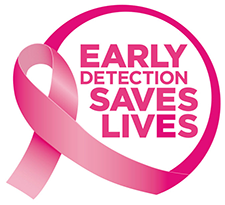What is mammography?
Mammography is pro-bably the most important tool doctors have to help them diagnose, evaluate, and follow women who’ve had breast cancer and also for screening women for breast cancer.
Safe and highly accurate, a mammogram is an X-ray photograph of the breast. The technique has been in use for about thirty years. It can detect most breast cancers at an early stage, before symptoms develop. Routine mammography is not available to women under 30 unless you have a first degree relative (mother or sister) who has had breast cancer at a young age.
Why is mammography important?
 Mammography saves lives. About 1 in 12 women develop breast cancer at some stage in life, mostly over the age of 50. The earlier breast cancer is detected, the better the chance of a cure.
Mammography saves lives. About 1 in 12 women develop breast cancer at some stage in life, mostly over the age of 50. The earlier breast cancer is detected, the better the chance of a cure.
Finding breast cancers early with mammography has also meant that many more women being treated for breast cancer are able to keep their breasts. When caught early, localized cancers can be removed without resorting to breast removal. Research studies have shown that mammography screening has significantly reduced the number of deaths from breast cancer.
When to get a mammogram?
There’s a lot of confusion about when and how often to get a mammogram. For now, the recommendation is that women get a mammogram once a year, beginning at age 40. If you’re at high risk for breast cancer, with a strong family history of breast or ovarian cancer, or have had radiation treatment to the chest in the past, it’s recommended that you start having annual mammograms at a younger age (often beginning around age 30).
What if there is an abnormality?
Most women have a normal mammogram. Some women are asked to attend again if the X-ray picture is not clear, or to look more closely at a special area of the breast which needs a further detailed check. A small number are found to have early breast cancer and are offered referral to a surgeon for treatment. If any abnormality is detected, the patients would be advised to have an ultrasound of the breast with FNAC (A small needle would be put through the area of abnormality with or without ultrasound guidance, where cells would be taken from that site and sent for microscopic evaluation for cancer cells.)
Three important things to know about mammograms
1. They can save your life. Finding breast cancer early reduces your risk of dying from the disease by 25-30% or more. Women should begin having mammograms yearly at age 40, or earlier if they’re at high risk.
2. Don’t be afraid. It’s a fast procedure (about 5-10 minutes), and discomfort is minimal. The procedure is safe: there’s only a very tiny amount of radiation exposure from a mammogram. To relieve the anxiety of waiting for results, go to a centre that will give you results before you leave.
3. It is our most powerful breast cancer detection tool. However, mammograms can still miss 15-20% of breast cancers that are simply not visible using this technique. Other important tools-such as breast self-exam, clinical breast examination, ultrasound, and MRI can and should be used as complementary tools, but there are no substitutes or replacements for a mammogram.